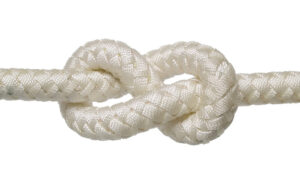I’ve heard it time and time again, “I’ve got so many knots. I need a deep tissue massage!”
Let’s first, look at muscle “knots.” Muscle fibers are stringy and aligned. When a section becomes misaligned or wadded up, we feel that “knot.”
It would help to understand that knots are text messages from our body telling us something is wrong. (Short, not very clear and, when repeated, annoying.) That muscle is tight in response to an instability or compensation. And, more often than not, the source of the problem is rarely where we feel the knot or pain.
The reason traditional massages feel great on the table but start to wear off immediately once your feet hit the ground is because that elbow in your knot is just addressing the symptom.
Once you put your body back under load, your brain steps in and reminds the body of the dysfunction and it reverts back to the compensation pattern that caused the knot in the first place.
Sometimes tight muscles are just from over-use and working them out is the fix; but if you find yourself back at the massage table every week with the same knots, or worse, then perhaps something else is going on.
Working the knots out through deep pressure is usually painful. Most people that love deep tissue massages love that “hurts so good” feeling but that pain is the body telling you that it doesn’t like what it is feeling, aka trauma.
When the body experiences trauma it will do what it can to prevent it from getting worse and sometimes that means sending more tension to the area than was there to begin with.
The key to lasting relief is finding out what is causing the tension to begin with. After addressing the problem and reeducating the brain that functional movement is preferred over compensation patterns, then the body will accept the new normal.
How do you get this? Find a therapist that will Practice LATER
Listen
Assess
Test
Evaluate
Repeat
Listen: You know where you hurt. You may not know the origin, but a good massage therapist will listen to the words you use and translate that into what the body is trying to tell you.
Assess: Taking their experience and your words gives the therapist a jumping off point to begin the search.
Test: From muscle testing to movement testing, these actions are quantifiable and repeatable. Seeing what your body is doing and what its limits are can be important clues into the disfunctions of the body.
Evaluate: It is not about just telling you to do an overhead squat or walk across the room, the therapist must then be able to say “you are favoring your right side, your pelvis has an anterior tilt, and that forward lean means your back muscles are weak.”
Repeat: After going through all of this, the therapist will then develop a treatment plan, execute the treatment plan then repeat the process to verify improvement. It may be weeks or months before you are going to test again, but that test should come and when it does, improvement should be noted.
More importantly, discovery of secondary compensations may come up. Just because your back no longer hurts, doesn’t mean your knees won’t start if the pattern was hidden.
The goal for most of our clients is get to functional movement state where you move and feel good, then get monthly maintenance, this maintenance will keep you at the top of your game.
I would love to know what you thought about the article. Comment here or over at our Facebook Page. Your input matters.
Good explanation of muscle knots . Yes muscles that get released don’t always hold . It sometimes takes a series of massages to Re- educate the muscles to.let go . Thankyou for sharing! 😁